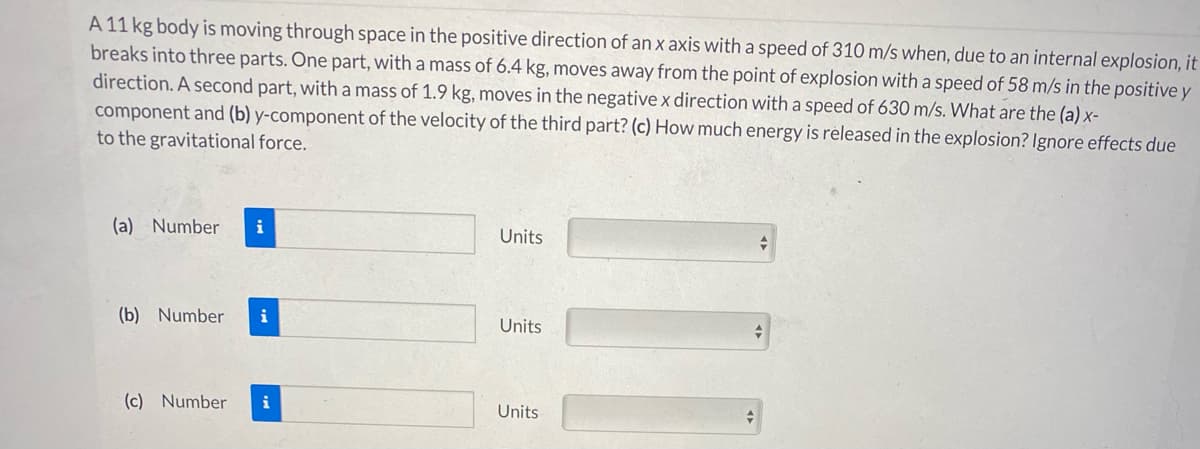A 11 kg body is moving through space in the positive direction of an x axis with a speed of 310 m/s when, due to an internal explosion, breaks into three parts. One part, with a mass of 6.4 kg, moves away from the point of explosion with a speed of 58 m/s in the positivey direction. A second part, witha mass of 1.9 kg, moves in the negative x direction with a speed of 630 m/s. What are the (a) x- component and (b) y-component of the velocity of the third part? (c) How much energy is released in the explosion? Ignore effects due to the gravitational force.
A 11 kg body is moving through space in the positive direction of an x axis with a speed of 310 m/s when, due to an internal explosion, breaks into three parts. One part, with a mass of 6.4 kg, moves away from the point of explosion with a speed of 58 m/s in the positivey direction. A second part, witha mass of 1.9 kg, moves in the negative x direction with a speed of 630 m/s. What are the (a) x- component and (b) y-component of the velocity of the third part? (c) How much energy is released in the explosion? Ignore effects due to the gravitational force.
Principles of Physics: A Calculus-Based Text
5th Edition
ISBN:9781133104261
Author:Raymond A. Serway, John W. Jewett
Publisher:Raymond A. Serway, John W. Jewett
Chapter8: Momentum And Collisions
Section: Chapter Questions
Problem 31P
Related questions
Topic Video
Question

Transcribed Image Text:A 11 kg body is moving through space in the positive direction of an x axis with a speed of 310 m/s when, due to an internal explosion, it
breaks into three parts. One part, with a mass of 6.4 kg, moves away from the point of explosion with a speed of 58 m/s in the positive y
direction. A second part, witha mass of 1.9 kg, moves in the negative x direction with a speed of 630 m/s. What are the (a) x-
component and (b) y-component of the velocity of the third part? (c) How much energy is released in the explosion? Ignore effects due
to the gravitational force.
(a) Number
i
Units
(b) Number
i
Units
(c) Number
i
Units
Expert Solution
This question has been solved!
Explore an expertly crafted, step-by-step solution for a thorough understanding of key concepts.
This is a popular solution!
Trending now
This is a popular solution!
Step by step
Solved in 2 steps with 2 images

Knowledge Booster
Learn more about
Need a deep-dive on the concept behind this application? Look no further. Learn more about this topic, physics and related others by exploring similar questions and additional content below.Recommended textbooks for you

Principles of Physics: A Calculus-Based Text
Physics
ISBN:
9781133104261
Author:
Raymond A. Serway, John W. Jewett
Publisher:
Cengage Learning

Physics for Scientists and Engineers, Technology …
Physics
ISBN:
9781305116399
Author:
Raymond A. Serway, John W. Jewett
Publisher:
Cengage Learning

Physics for Scientists and Engineers with Modern …
Physics
ISBN:
9781337553292
Author:
Raymond A. Serway, John W. Jewett
Publisher:
Cengage Learning

Principles of Physics: A Calculus-Based Text
Physics
ISBN:
9781133104261
Author:
Raymond A. Serway, John W. Jewett
Publisher:
Cengage Learning

Physics for Scientists and Engineers, Technology …
Physics
ISBN:
9781305116399
Author:
Raymond A. Serway, John W. Jewett
Publisher:
Cengage Learning

Physics for Scientists and Engineers with Modern …
Physics
ISBN:
9781337553292
Author:
Raymond A. Serway, John W. Jewett
Publisher:
Cengage Learning

Physics for Scientists and Engineers: Foundations…
Physics
ISBN:
9781133939146
Author:
Katz, Debora M.
Publisher:
Cengage Learning

Physics for Scientists and Engineers
Physics
ISBN:
9781337553278
Author:
Raymond A. Serway, John W. Jewett
Publisher:
Cengage Learning